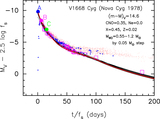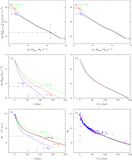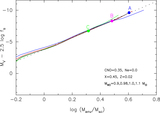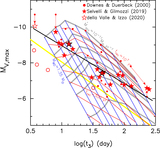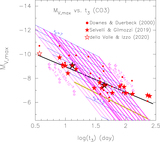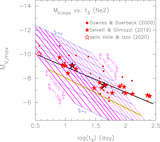Image Details
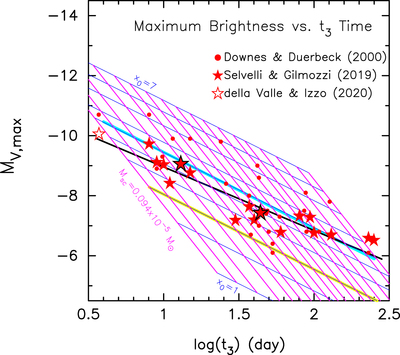
Caption: Figure 5.
Maximum V magnitude ﹩{M}_{V,\max }﹩ against the rate of decline t3 for various equi-Msc (solid magenta lines) and equi-x0 (solid blue lines) models. The ﹩{M}_{V,\max }﹩ and t3 are calculated from Equations (33) and (32), respectively. The filled red circles and stars are for galactic novae obtained by Downes & Duerbeck (2000) and Selvelli & Gilmozzi (2019), respectively. We also add an open red star at the position of V1500 Cyg taken from della Valle & Izzo (2020). The outlined red star at upper left is GK Per, while the one at lower right is V533 Her. The thick cyan line represents the “classical” MMRD relation defined by Downes & Duerbeck (2000), i.e., ﹩{M}_{V,\max }=-11.99+2.54\mathrm{log}({t}_{3})﹩, while the thick black line represents the linear MMRD relation defined by Selvelli & Gilmozzi (2019), i.e., ﹩{M}_{V,\max }=-11.08+2.12\mathrm{log}({t}_{3})﹩. The solid magenta lines connect the same scaling mass Msc but for different x0. The scaling masses are, from right to left, the same as those tabulated in Table 3. The solid blue lines connect the same x0, i.e., x0 = 1, 1.5, 2, 2.5, 3, 3.5, 4, 5, 6, and 7, from bottom to top. The thick yellow line corresponds to the x0 = 2 line, above which Equation (32) is approximately valid. The magenta lines of equi-Msc have a slope of 6.3, while the blue lines of equi-x0 have a slope of 2.5 in the ﹩(\mathrm{log}{t}_{3})﹩–﹩{M}_{V,\max }﹩ diagram.
Copyright and Terms & Conditions
© 2020. The American Astronomical Society. All rights reserved.


